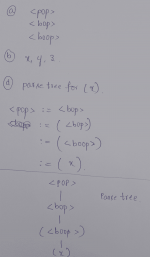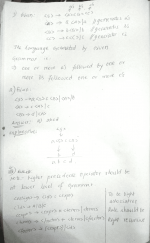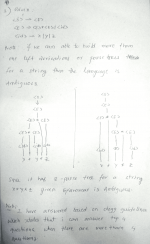Unkown User
Eternal Poster
- TS TS
- #101
I.

(10 bookmarks)

1. A n-type piece of silicon experiences an electric field equal to 0.1 V/m.
a. Calculate the velocity of electrons and holes in the material.
b. What doping level is necessary to provide a current density of 1 mA/m^2 under these
conditions? Assume the hole concentration is negligible.
2. A n-type piece of silicon with a length of 0.1 m and cross section area of 0.05 m x 0.05 m sustains a voltage difference of 1 V. If the doping level is 10^17cm^-3, calculate the total
current flowing through the device T=300K.
3. The figure shows a p-type bar of silicon that is subjected to electron injection from left and
hole injection from right. Determine the total current flowing through the device if the cross
section area is equal to 1 m x 1m.
4. Due to a manufacturing error, the p-side of a pn junction has not been doped. If
ND=3X10^13cm^-3, calculate the built-in potential barrier at T=300K.
5. A junction employs ND= 5 x 10^17cm^-3, and NA= 4 x 10^16cm^-3,
a. Determine the majority and minority carrier concentrations on both sides.
b. Calculate the built in potential at 250K, 300K, and 350K.
6. We have received the circuit shown in the figure and wish to determine R-sub1 and I-sub-s.
We note that Vx=1v-->Ix=0.2mA and Vx=2V-->Ix=0.5mA. Calculate R 1and I.s
7. IfIs= 3 x 10^16A, calculate VD1 for IX=1 mA, 2mA, and 4mA.
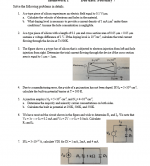
Show transcribed image text
Best Answer
II.

(3 bookmarks)


Show transcribed image text
III.

(5 bookmarks)

Two identical pn junctions are placed in series.
a) prove that this combination can be viewed as a single two-terminal device having an exponential characteristic.
b) For a tenfold change in the current, how much voltage change does such a device require?
please write it clearly!!
Question: 1. A n-type piece of silicon experiences an electric ...

(10 bookmarks)
1. A n-type piece of silicon experiences an electric field equal to 0.1 V/m.
a. Calculate the velocity of electrons and holes in the material.
b. What doping level is necessary to provide a current density of 1 mA/m^2 under these
conditions? Assume the hole concentration is negligible.
2. A n-type piece of silicon with a length of 0.1 m and cross section area of 0.05 m x 0.05 m sustains a voltage difference of 1 V. If the doping level is 10^17cm^-3, calculate the total
current flowing through the device T=300K.
3. The figure shows a p-type bar of silicon that is subjected to electron injection from left and
hole injection from right. Determine the total current flowing through the device if the cross
section area is equal to 1 m x 1m.
4. Due to a manufacturing error, the p-side of a pn junction has not been doped. If
ND=3X10^13cm^-3, calculate the built-in potential barrier at T=300K.
5. A junction employs ND= 5 x 10^17cm^-3, and NA= 4 x 10^16cm^-3,
a. Determine the majority and minority carrier concentrations on both sides.
b. Calculate the built in potential at 250K, 300K, and 350K.
6. We have received the circuit shown in the figure and wish to determine R-sub1 and I-sub-s.
We note that Vx=1v-->Ix=0.2mA and Vx=2V-->Ix=0.5mA. Calculate R 1and I.s
7. IfIs= 3 x 10^16A, calculate VD1 for IX=1 mA, 2mA, and 4mA.

Show transcribed image text
Best Answer

William Jonesanswered this
Was this answer helpful?
14
0
310 answers
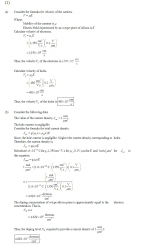
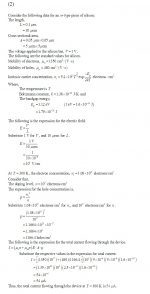
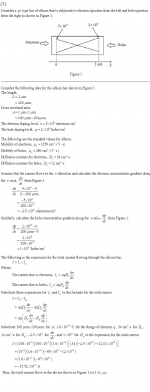
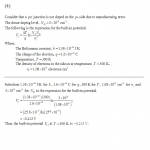
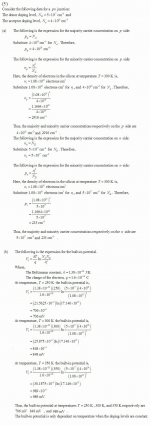
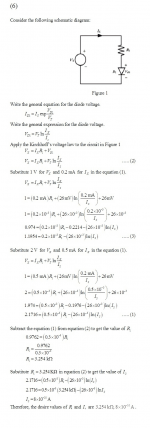
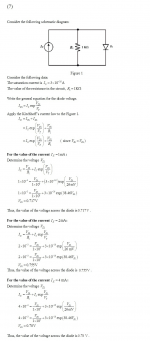
Answer question
You do not have permission to view the full content of this post. Log in or register now.
More Answers

Anonymousanswered this
Was this answer helpful?
0
1
408 answers
1.
see the required equation is
Vd = u*E where Vd is the drift velocity and u is the mobility, E is the field.
here mobility is the dominant factor because it depends on a lot of things. which must be given. othwerwise you can't guess the velocity.
although in general in undoped silicon velocity is higher than in doped silicon for both electron and holes.
b)
here the current density is given by
J = n*e*Vd
where n is the carrier concentration, e is the electronic charge and Vd is the drift velocity.
from the above calculated velocity we can find out n.
2. voltage is given so field accross the bar can be foun out
E = V/d , where d is the length of the bar.
= 10 V/m
now as we know
I = J*A = n*e*A*Vd
where n is electron charge and A is the area. just put values and get the current value.
remember Vd = u*E where u is the mobilty which must be mentioned. mobility alos depends on temperature.
3. here the curren is due to diffusion. the formula for this
A = A*D*e*dQ/dx
where A area, D is diffusion constant, dq/dx is the carrier concentration gradient.
the above values need to be give for calculation.
if the carries injection is done from a battery souce then there will be significant current.
if it is only charge bombarding then at some point there will be equillibrium and current will be zero.
4. builtin potential is given by,
Vbi = (kT/q)*(ln(NA*ND/ni^2))
where k is the boltzman constant, q the electron charge, NA acceptor ion concentration, ND donar ion concentration, ni is the intrinsic concentration or undoped silicon concentration.
here as NA = ni as there is no P type doping so
Vbi = (kT/q)*(ln(NA/n)) ; kT/q =0.026 V put the value and get theresult.
5. ND= 5 x 10^17cm^-3, and NA= 4 x 10^16cm^-3 and from mass law action we know
NA*ND = ni^2
from the information of the ni in each side calculate NA in the n side and ND in the p side.
which is greater in magnitude that is the majority carrtier and the other one is the mainority carrier.
fror the biult in potential use the formula as
Vbi = (kT/q)*(ln(NA*ND/ni^2))
6.
there are two governing equation here,
(1-Vd1)/R1 = Is*exp(q*Vd1/kT) = 0.2 m--------------------------1
(2-Vd2)/R1 = Is*exp(q*Vd2/kT) = 0.5 m--------------------------2
solving the two equationds we get
2.5 Vd1 - Vd2 = 0.5 and Vd2 - Vd1 = 0.0238
or Vd1 = 0.373 V and Vd2 = 0.3492 V
put this vaues in the corresponding above equation you get, Is = 2.938 *10^-10 A and R1 = 3.254 K ohm.
7. t he governing formula is
Ix = Vd/R1 + Is*exp(q*Vd/k*T) whre k is the boltzman costant and T is the teperature.
put all the values you will get equations on which you need to do iterative process to find out Vd's. because the equations are nonlinear.
You do not have permission to view the full content of this post. Log in or register now.
II.
Question: Consider a pn junction in forward bias: To obtain a current of 1 mA with a voltage of 750 mV, ho...

(3 bookmarks)

Show transcribed image text
Expert Answer

James KennedyChegg expert answered this
Was this answer helpful?
1
0
3,567 answers
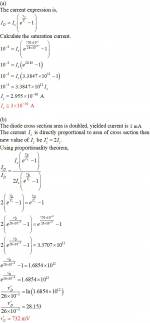
You do not have permission to view the full content of this post. Log in or register now.
III.
Question: Two identical pn junctions are placed in series. a) prove that this combination can be view...

(5 bookmarks)
Two identical pn junctions are placed in series.
a) prove that this combination can be viewed as a single two-terminal device having an exponential characteristic.
b) For a tenfold change in the current, how much voltage change does such a device require?
please write it clearly!!
Expert Answer

James KennedyChegg expert answered this
Was this answer helpful?
0
0
3,567 answers
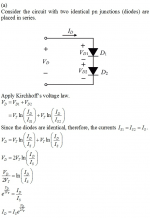
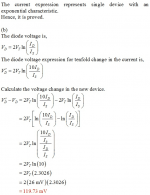
You do not have permission to view the full content of this post. Log in or register now.
Attachments
-
You do not have permission to view the full content of this post. Log in or register now.

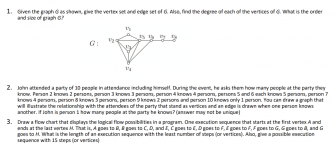
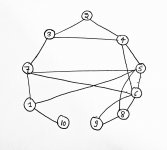


 Godbless po
Godbless po 




![1. Consider the grammar given below (5 points) <pop> = [<bop>, <pop>] | <bop> <bop> := <boop> |( <bop> ) <boop> =:= x | y | z 1. Consider the grammar given below (5 points) <pop> = [<bop>, <pop>] | <bop> <bop> := <boop> |( <bop> ) <boop> =:= x | y | z](/proxy.php?image=https%3A%2F%2Fmedia.cheggcdn.com%2Fstudy%2F20c%2F20ccca66-4c26-436e-bcc5-0093c0d63806%2Fimage.png&hash=b1474810c9e74e7595c8a2eac3e59c34)
